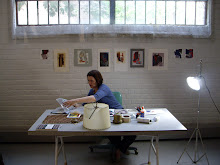My work is created through a Tachist approach and I choose to use the term ‘poemagogic imagery’ due to the word ‘image’ being confused with narrative, photography and notion of art being preconceived. When I create art I do not consider that I am creating an image. I consider my work an embodied object that has been created through feeling and form. A virtual world is created through the picture plane and the essence of any imagery, or memory it provokes has been idealised through an abstraction. This approach may be considered reductive or conceptual – but my interest in art making is connected to Lyrical, Tachism and Abstract Expressionism and could be considered Post-painterly or even Romantic.
Whilst I value formalism, the spaces I seek to create are not derivative of a Greenberg flat space and I aim to capture a virtual pictorial world within my work - not an image. Spaces I create are often ambiguous, hidden and architectonic and marks on the picture plane are considered passages and areas. Whilst I acknowledge there is a proliferation of multi-discipline practise and artists reacting to Greenberg through extending their canvas off the wall into situational painting, BMT, installation and alike. I choose to create art that values pictorial problem solving and drawing is a direct method to access this cognitive and affective domain. My work relates to forms that convey internal human feelings and states of being. This poetic based approach to capturing a visual percept is in Rothko’s monoloithic forms, tactile spaces of Hamilton and Hesse, Kandinsky and Klee’s theories and art informal influenced artists such as Twombly and Tapies. Drawing offers solutions for formalism that have struggled to come to terms with the proclaimed ‘death of painting’ and conceptual theories of painting. Drawing to me is a conduit to the unconscious inner life of the artist and ‘Poemagogic images. It is this essential space that is connected to the unconscious that I am interested in capturing within my work and seek to understand.
